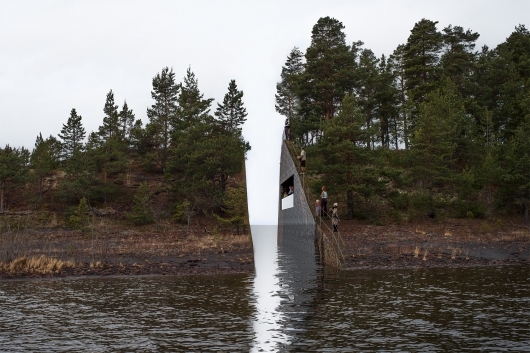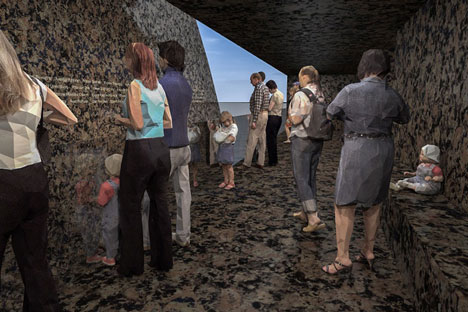Today, the immediate grief and exhaustion following Norway’s tragic July 22, 2011 attacks have passed. But as Swedish designer Jonas Dahlberg says, this doesn’t mean “the wound” of the painful deaths has been forgotten. If anything, says Dahlberg, the sensation of loss from the Norway 2011 attacks resonates as the years go by and families cope with voids that can’t be filled. This reality is what informs the designer’s “active and poetic” plans for the tragedy’s memorial site.
“If anything, says Dahlberg, the sensation of loss from the Norway 2011 attacks resonates as the years go by and families cope with voids that can’t be filled.”
“An emotional observation informs my overall concept,” says Dahlberg, “During the initial site visit to [the tragic site], I noticed how different the feeling was of walking outside in nature, compared to the feeling of seeing the vacant rooms and the traces of extreme violence [in the buildings] and [it] brought me — and others around me — to a state of profound sadness. In its current state, the building kept close within it the memory of the terror acts of July 22, 2011. [It was] like an open wound.”
The natural landscape surrounding the building provided a stark contrast to the memories of death so ingrained in the public because, simply put, nature moves on. It continued to grow as green as ever, though it will forever be inextricably bound to a place of death and loss. “We stood directly on the place where many people had lost their lives,” says Dahlberg, “[and] nature had already begun to obscure all traces. The Temporary and Permanent Memorials in the Government Quarter grow from this seed, yet they proceed and carefully consider their own site-specific physical, social and political aspects.”
The design for Norway’s 2011 memorial “proposes a wound or a cut within nature itself” by actually slicing three-and-a-half-meters into the land at the Sørbråten site, making tangible the sensation of irreplaceable loss.
“It reproduces the physical experience of taking away, reflecting the abrupt and permanent loss of those who died,” he says about the memorial site, where “visitors begin their experience guided along a wooden pathway through the forest, [which] creates a five to ten minute contemplative journey leading to the cut. Then the pathway will flow briefly into a tunnel, [which] leads to the dramatic edge of the cut itself. Visitors will be on one side of a channel of water created by the cut [while] across, on [a] stone surface of the other side, the names of those who died will be visibly inscribed in the stone; [they’ll be close] enough to see and read clearly — yet ultimately out of reach. The cut is an acknowledgement of what is forever irreplaceable.”
“It reproduces the physical experience of taking away, reflecting the abrupt and permanent loss of those who died.”
–Jonas Dahlberg
Hopefully, Jonas Dahlberg’s memorial can give closure to those affected by the Norway 2011 attacks. The Swedish designer’s plan embodies the pain that surviving friends and family feel through a fiercely present memorial. It is both sobering and inspiring in its presence, and we can’t wait to see it erected.
You may enjoy:
- Norway’s Cemetery Skyscraper Design
- Ancient Nordic Viking Funeral Burials Reflect Common World Traditions
- “Death in the Sick Room” by Edvard Munch

 Jonas Dahlberg to Design Norway’s July 22, 2011 Memorial Site
Jonas Dahlberg to Design Norway’s July 22, 2011 Memorial Site





 “As Tears Go By” by Marianne Faithfull
“As Tears Go By” by Marianne Faithfull

 Funeral Favors Offer Visitors a Tangible Memento
Funeral Favors Offer Visitors a Tangible Memento















